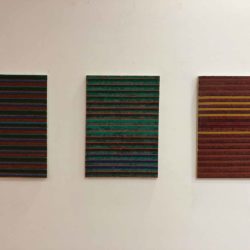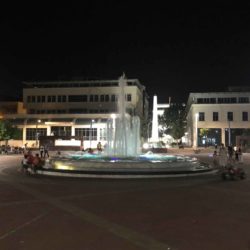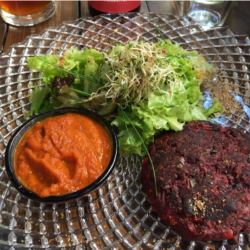
There’s a lot more to do in Cetinje than hunt down former embassies (link to previous post); it really is a marvel that this erstwhile capital has remained under the radar from the hordes of tourists on the Montenegrin coast. The city is small enough to walk past all of these buildings in an hour or two, but you should budget more time check out some of the excellent museums housed within.
I started out at the former Montenegrin Parliament, where the Narodni muzej Crne Gore (National Museum of Montenegro) has turned the ground floor into the Historical Museum and the first floor into the Art Museum of Montenegro.
You can purchase admission separately, but it’s best to spend the 10€ for a museum pass that will get you into both, as well as the Ethnographical Museum, King Nikola’s Museum and the Biljarda.

When I entered the Historical Museum I was told I could wander on my own or wait for a small group to form and then be taken through by an English-speaking guide (for free). It was worth the wait, as the guide was excellent and he indulged my numerous questions about Montenegrin history under Tito and the path towards independence after Yugoslavia fell apart; Montenegro did not gain full independence until 2006, making it one of the youngest nations in the world.
The highlight of the art museum was easily their collection of works from Montenegrin painter Milo Milunović, who was born in Cetinje, but also lived and studied in Florence, Paris, Zagreb and Belgrade. The art history class I took in college focused almost entirely on the painters of the Italian Renaissance and the French masters, and I think that’s where fine art education ends (if it even has begun) for many Americans. A common theme I found while traveling around The Balkans was how drawn I was to the modern art galleries (1900 onwards), connecting with the artists on an emotional level in a way I never had with Botticelli and da Vinci.

King Nikola I was the ruler of Montenegro, first as prince and later as king, from 1860-1918. After WWI, Montenegro was absorbed by Serbia, and later becoming part of Yugoslavia. Nikola lived out the rest of his years in France with his wife, Queen Milena. In 1989 their bodies were returned to Cetinje and have been reburied alongside Ivan Crnojević, who founded the city in 1482.
The King brought about great social change, including education reform and granting freedom to the press. He was also a military hero, the ground floor of his museum is mostly devoted to showing off his various medals and other accoutrement. The first floor allows you to see 13 rooms decorated as they would have been in the days of the King’s reign.

Right next to the King Nikola’s old royal residence is the Biljarda, a fortress built in 1838 by Prince-Bishop Petar II Petrović-Njegoš. The building got its name from the billiard table Njegoš had installed in the main room where the senate also convened. In addition to Njegoš’s political and religious duties he was also a poet, dramatist and philosopher. The museum contains the original manuscript of his most well-known work, The Mountain Wreath, which was an epic poem presented as play that called for the unification of all Montenegrin and Serbian people.

The Dvoska Crkva was built atop the ruins of several previous churches by King Nikola in 1890. The church now acts as the mausoleum for Nikola and his wife and became part of the National Museum in 2012.

The Plavi Dvorac was built in 1895 as a residence for Prince Danilo, King Nikola, oldest son. Even though Podgorica is now the official capital of Montenegro, the President still resides here in Cetinje. I asked one of the guards if it was ok for me to take a picture- it’s always wise to ask before you start snapping photos of government and/or military buildings- and he told me to go right ahead!

Right behind the Plavi Dvorac is Njegošev Park, a lovely, shaded spot where I journaled for 30 minutes and escaped the brutal August heat.

A monastery has stood on this site in one form or another since 1485, but has been burned down, destroyed and rebuilt more times than one can count. Maybe it was simply bad luck, but the dress code was being strictly enforced when I visited and I couldn’t enter wearing shorts. This only gives me another reason to return to Cetinje in a cooler month when I’m wearing pants!

You can’t leave Cetinje without stopping by the small park that pays homage to the founder of Cetinje, Ivan Crnojević. He looks happy and at peace with his city, and that’s exactly how I felt the entire time I was there. Being so close to Podgorica made this the ideal day trip to deepen my understanding of Montenegro’s history and culture and I urge everyone else to do the same.


